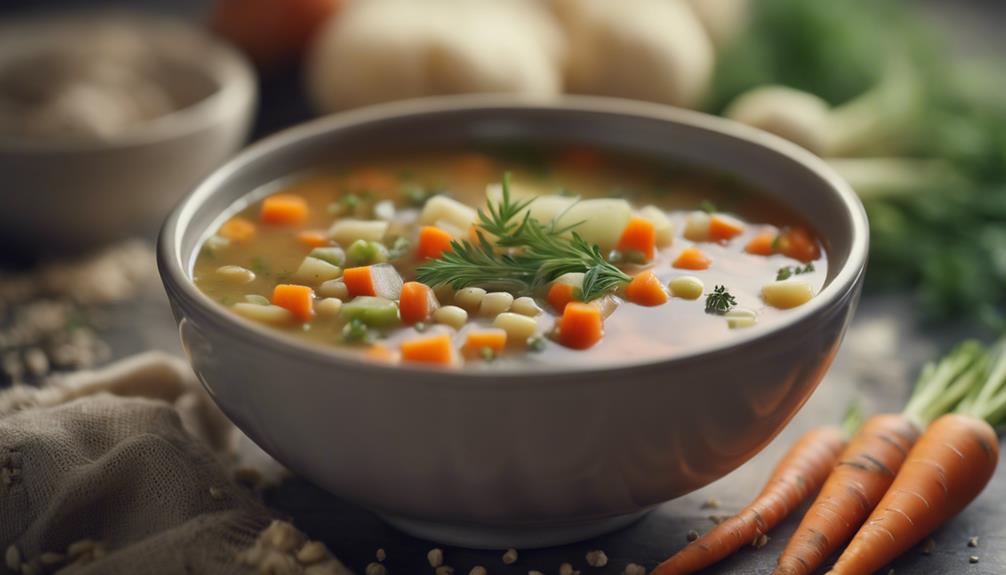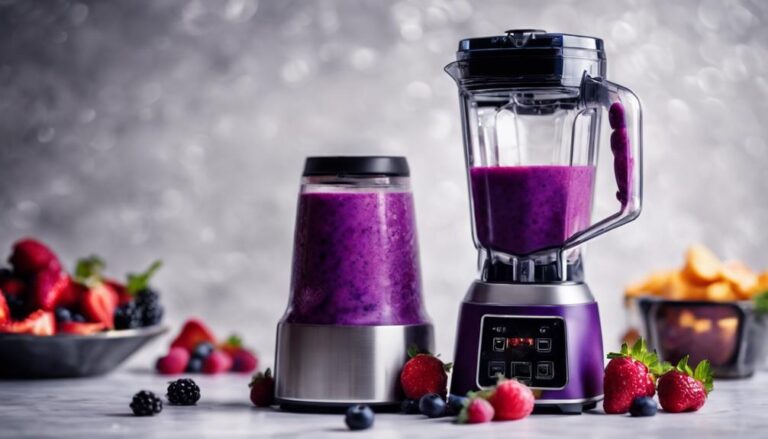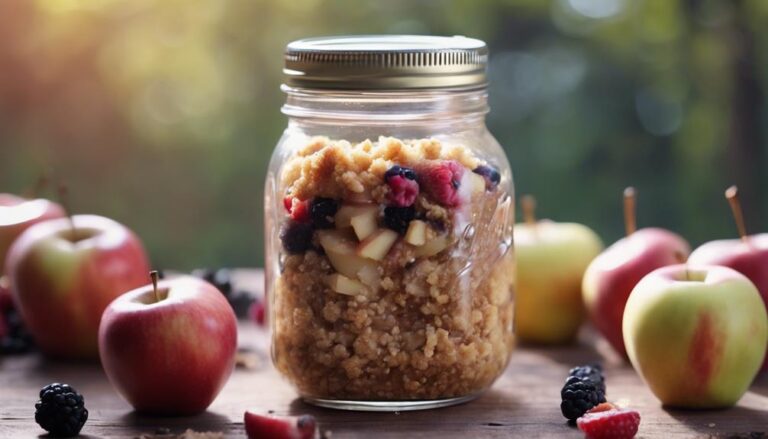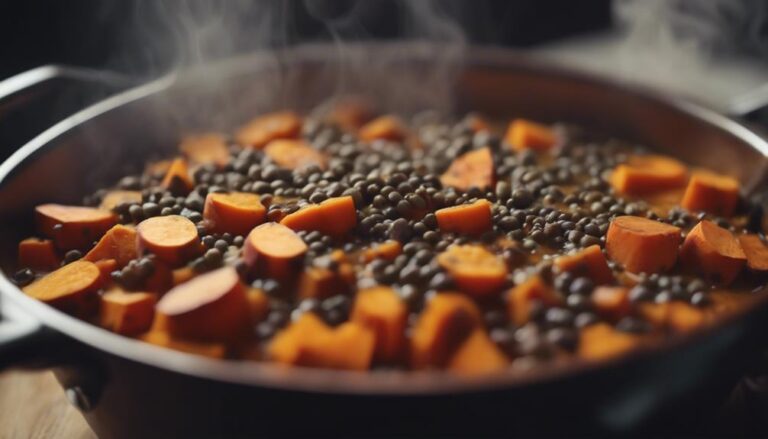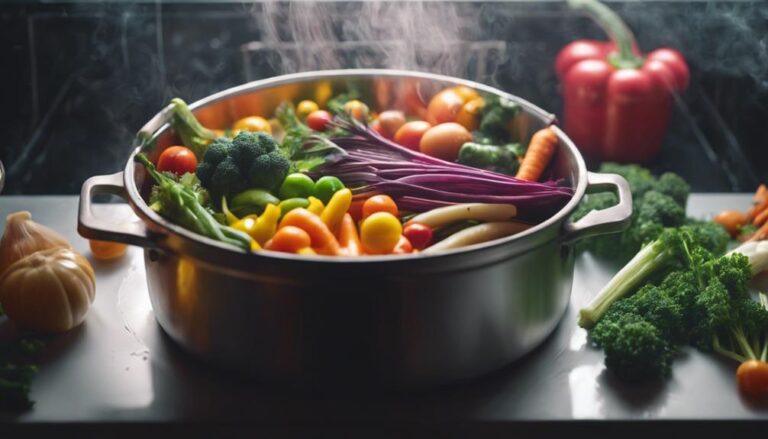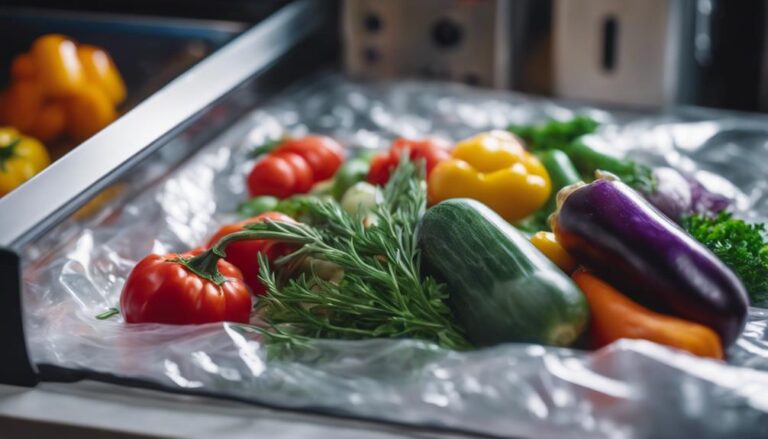Sous Vide Winter Vegetable Soup With Barley
Step into a comforting world of Sous Vide Winter Vegetable Soup with Barley. Enjoy the cozy blend of winter veggies, nutty barley, and the precision of sous vide cooking. Let the subtle flavors of root vegetables like butternut squash and carrots infuse with the hearty texture of barley. Elevate the aromatic profile with fresh herbs like parsley and bay leaves. Delight in a vegan-friendly, nourishing meal that celebrates the seasonal goodness in a wholesome way. Discover the perfect balance of flavors and textures in this delightful dish.
What You Will Learn Here
- Barley adds hearty texture and nutty flavor to the soup.
- Root vegetables like butternut squash and parsnips stay firm and flavorful.
- Fresh herbs like parsley and bay leaves enhance the aromatic profile.
- Vegan-friendly dish celebrating seasonal produce in a nourishing way.
- Sous vide cooking method preserves nutrients and flavors of the vegetables.
Soup's Ancient Origins
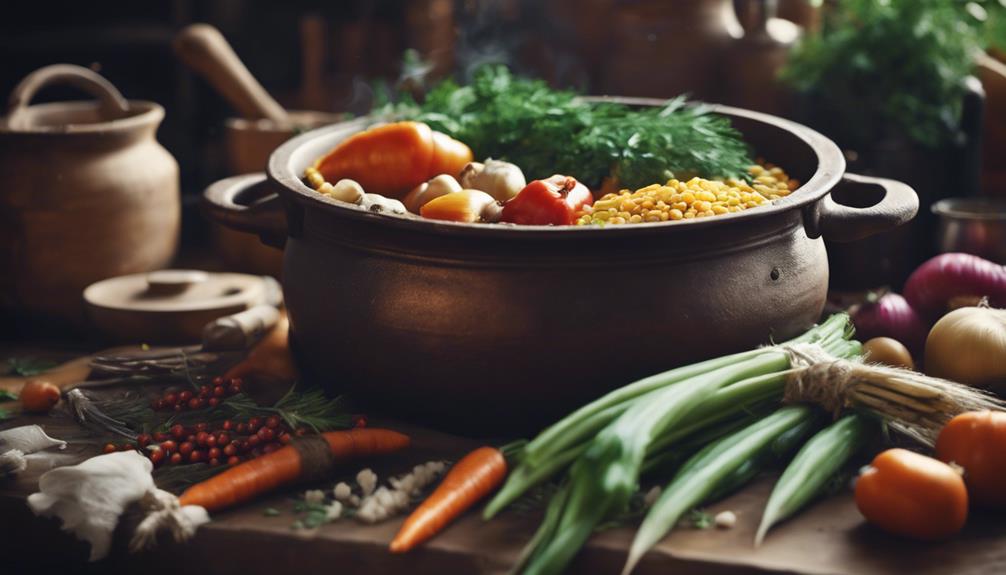
Soup has a rich historical lineage, tracing back to ancient times when it was valued for its nourishing properties and healing qualities.
The evolution of soups over the centuries reflects the diverse cultural influences and culinary innovations that have shaped this beloved dish.
From the humble beginnings of bread-soaked broths to the sophisticated techniques of modern sous vide cooking, soup continues to hold a special place in global gastronomy.
Soup's Historical Roots
Having ancient origins dating back to around 6000 BC, evidence found in archaeological sites in China suggests the early beginnings of this nourishing and easily digestible meal known today as soup. Initially crafted by boiling vegetables, barley, and other ingredients in broth, soups provided warmth and sustenance during winter months.
Throughout history, soups have been a staple in various cultures, with each region adding its unique twist to recipes, reflecting local ingredients and culinary traditions. The hearty nature of winter vegetable soup with barley speaks to the long-standing history of soups as a comforting and filling dish, showcasing the evolution of combining simple ingredients into a flavorful and satisfying meal that has stood the test of time.
Evolution of Soups
With origins dating back to ancient times, the evolution of soups traces a culinary journey rich in history and tradition. Soups have been a staple across various cultures, adapting to local ingredients and preferences. The cooking process has transformed from basic boiling to intricate methods like sous vide. Winter vegetables, pearl barley, and fresh herbs have become popular additions, enhancing the flavors of hearty vegetable soups. Vegetable broth serves as a base for many vegan winter vegetable soups, offering both nourishment and taste. Below is a table illustrating the evolution of soups through the introduction of new ingredients and techniques:
| Ancient Times | Medieval Era | Modern Era |
|---|---|---|
| Basic broths | Thickened soups | Fusion cuisine |
| Limited ingredients | Spices added | Diverse flavors |
| Utilitarian purpose | Elite delicacy | Trendy superfoods |
Cultural Significance of Soup
In the culinary world, uncovering the origins of soup reveals a tapestry of ancient traditions and cultural significance. Vegetable soup, with its ancient origins dating back to around 20,000 BC, reflects the essence of traditional soups found in various cultures worldwide. These soups, like Chinese hot and sour soup, Italian minestrone, and French onion soup, have been a cornerstone of culinary tradition, utilizing regional ingredients and diverse cooking techniques.
Soup's ability to provide nourishment and its evolution over time to accommodate cultural preferences showcase its adaptability and importance in societies. The term 'soup,' originating from the Old French word 'soupe,' underscores the humble beginnings of this beloved dish that continues to unite people through shared culinary experiences.
Barley as a Nutritious Addition
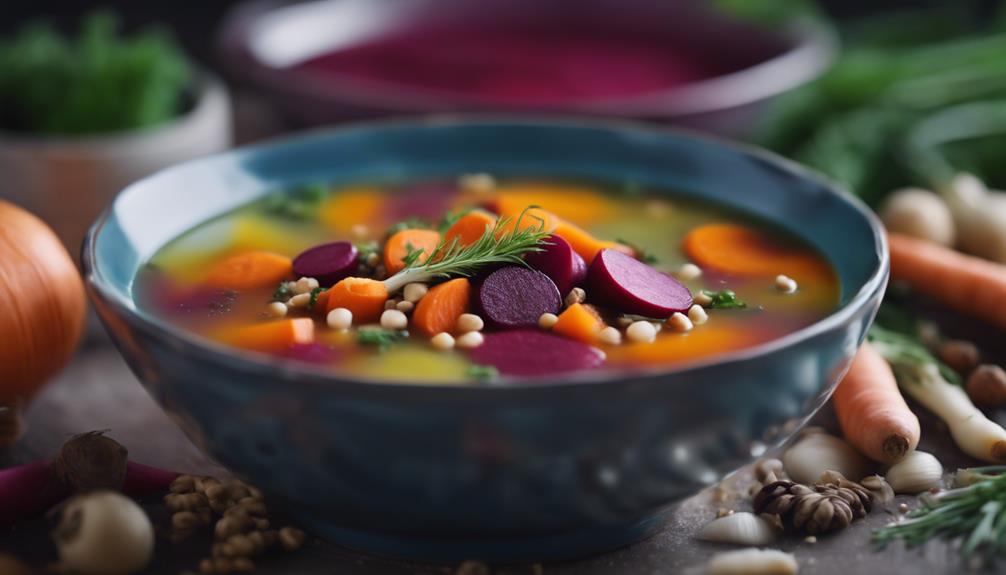
Barley, a powerhouse whole grain packed with fiber, vitamins, and minerals, elevates the nutritional value and taste of winter vegetable soup. When added to a vegan winter vegetable soup, barley brings a plethora of health benefits to the table:
- Essential in Fiber: Barley is an excellent source of fiber, aiding in digestion and promoting a feeling of fullness, which can support weight management.
- Crucial in Vitamins and Minerals: This whole grain contains essential nutrients like manganese, selenium, and phosphorus, which are crucial for overall health and well-being.
- Plant-Based Protein: For those following a plant-based diet, barley is a valuable source of protein, helping to meet daily protein requirements in a meat-free meal.
Incorporating barley into your winter vegetable soup not only enhances its nutritional content but also adds a delightful texture and depth of flavor. This ancient grain's versatility makes it a perfect addition to your pantry for creating wholesome and satisfying meals.
Top-rated Barley Soup Recipes
Explore the world of top-rated barley soup recipes that promise a warm, comforting experience.
Immerse yourself in the deliciousness of Barley and Lentil Stew, indulge in the heartiness of Hearty Winter Vegetable Stew, and savor the wholesome goodness of Hearty Vegetable Barley Stew.
Let these recipes elevate your winter dining with their rich flavors and satisfying textures.
Barley and Lentil Stew
Indulge in the hearty and nutritious goodness of a top-rated barley and lentil stew, a satisfying and customizable dish perfect for the winter season.
- Versatile and Customizable: This vegetarian stew can be tailored to suit individual preferences by adding a variety of vegetables, seasonings, and toppings.
- Nutrient-Rich: Packed with fiber, vitamins, and minerals, this stew offers a wholesome and healthy meal option during the colder months.
- Easy to Make: Enjoy the comforting flavors of barley and lentils in this easy-to-make dish that can be adapted to different dietary needs for a delicious and satisfying meal experience.
Hearty Winter Vegetable Stew
With its robust blend of seasonal vegetables and chewy barley, this top-rated winter stew promises a comforting and nutritious experience for cold evenings. Here's why this vegetable barley soup is a must-try:
- Hearty Winter Vegetables: The combination of seasonal root vegetables like carrots, parsnips, and turnips adds depth and earthy flavors to the stew.
- Nutritious and Fiber-Rich: Packed with fiber, vitamins, and minerals from the vegetables and barley, this soup isn't only delicious but also offers a healthy dose of nutrients.
- Thickening Agent: Barley not only provides a satisfying chewiness but also helps thicken the soup, creating a hearty and wholesome dish perfect for warming up during the winter months.
Hearty Vegetable Barley Stew
Shifting seamlessly from the hearty winter vegetable stew, the barley soup with a medley of vegetables promises a wholesome and flavorful experience perfect for chilly winter nights. When preparing this vegan winter vegetable barley stew, consider the following:
- Nutritious Base: Start by sautéing a mix of winter vegetables in olive oil before adding vegetable broth for depth of flavor.
- Hearty Grains: Introduce pearled barley to the pot, allowing it to simmer until tender, absorbing the savory broth.
- Enhanced Flavor: To enrich the stew, stir in diced tomatoes, enhancing the nutty undertones of the barley while adding a burst of freshness to each spoonful.
Craft a bowl of this hearty vegetable barley stew for a comforting and satisfying meal during the winter months.
Barley Soup Storage Tips
When storing barley soup, remember to keep it in the fridge for no more than three days to maintain its freshness.
For longer storage, freeze the soup in airtight containers or bags for up to four months.
To adjust the consistency of thawed barley soup, simply add extra liquid like broth or water.
Proper Barley Storage
For best storage of barley, place it in an airtight container in a cool, dry location to maintain freshness and prevent moisture absorption. Guarantee the container is kept away from heat sources, sunlight, and humidity to preserve the barley's quality.
Proper storage in a cool, dry place can help vegetable barley last up to a year without losing flavor or nutritional value. Avoid storing barley in the refrigerator or freezer as it can lead to moisture absorption and compromise texture.
Periodically check the stored barley for any signs of insects or mold growth, and promptly discard if any issues are detected to maintain the integrity of the barley for future uses.
Length of Storage
After properly storing your barley, it's important to understand the ideal length of storage for your delicious vegan winter vegetable barley soup. When refrigerated, your soup can maintain its best quality for up to three days.
If you opt to freeze it, the vegetable broth-based soup can last for up to four months. Upon thawing, consider adding extra stock as needed to adjust consistency, ensuring a satisfying texture.
To elevate the flavors of your stored soup, try incorporating a touch of lemon juice and zest, which can bring a revitalizing zing to each spoonful. Remember that proper storage and a few adjustments can help you enjoy your vegetable barley soup at its finest, even after some time has passed.
Ideal Storage Conditions
To ensure top freshness and quality for your vegan winter vegetable barley soup, proper storage conditions play an important role in preserving its flavors and texture. When storing your soup, refrigerate it for up to 3 days in a sealed container to maintain freshness. For longer storage, freeze the soup in airtight containers or freezer bags for up to 4 months. Remember that thawed barley soup may require additional liquid when reheating to adjust the consistency. To enhance the flavor of leftover soup, consider adding lemon zest and juice. If the soup thickens too much during storage and reheating, simply add extra stock or water to reach your desired consistency.
| Storage Tip | Details |
|---|---|
| Refrigeration | Up to 3 days in a sealed container |
| Freezing | In airtight containers or freezer bags for up to 4 months |
| Adjusting Consistency | Additional liquid may be needed when reheating to adjust the consistency |
| Flavor Enhancement | Add lemon zest and juice to enhance the flavor of leftover soup |
Final Thoughts
In considering the delightful blend of flavors and textures in this sous vide winter vegetable soup with barley, one can't help but appreciate the nourishing warmth it brings on cold winter days. The hearty texture and nutty flavor that the barley imparts to the soup create a comforting experience with each spoonful. Through the sous vide method, the winter soup achieves an even cooking process, ensuring that the root vegetables like butternut squash, parsnips, and carrots maintain their integrity while infusing the broth with their rich essence.
The addition of fresh herbs such as parsley and bay leaves elevates the aromatic profile of the soup, adding layers of freshness that complement the earthy tones of the vegetables. This vegan-friendly dish not only provides a hearty and wholesome meal but also serves as a versatile option for those seeking a warm and nourishing bowl during the colder months. Whether enjoyed as a light lunch or a cozy dinner, this sous vide winter vegetable soup with barley is a true celebration of seasonal produce and flavors.
Frequently Asked Questions
Should Barley Be Soaked Before Adding to Soup?
You should soak barley before adding it to soup. This step enhances nutrition, aids digestion, and reduces cooking time. Soaked barley contributes to a creamy texture, thickens the soup, and allows for better absorption of flavors.
Does Barley Get Mushy in Soup?
Barley texture in soup can vary based on cooking time. Follow cooking tips to make sure it's tender yet firm. Enhance the soup's flavor with barley's chewiness. Consider barley alternatives or different varieties. Balancing ingredients creates the desired soup consistency.
What if I Put Too Much Barley in My Soup?
If you put too much barley in your soup, adjust the barley ratio by adding more liquid for balance. Consider barley alternatives or varying the cooking time for texture. Play with vegetable pairings to enhance flavor and maintain a crunchy barley consistency.
Does Barley Help Thicken Soup?
Barley benefits your soup by acting as a natural thickening agent, enhancing its texture. Cooking techniques release starch, providing a creamy consistency. Besides thickening, barley adds nutritional value, binds flavors, and offers a satisfying chew.
Conclusion
Indulge in the comforting flavors of winter vegetable soup with barley, prepared using the sous vide method. The ancient origins of soup and the nutritious benefits of barley come together in this hearty dish.
With top-rated barley soup recipes and storage tips, you can enjoy this wholesome meal throughout the season.
Warm up with a bowl of this delicious soup and savor every bite of its rich and satisfying flavors.
